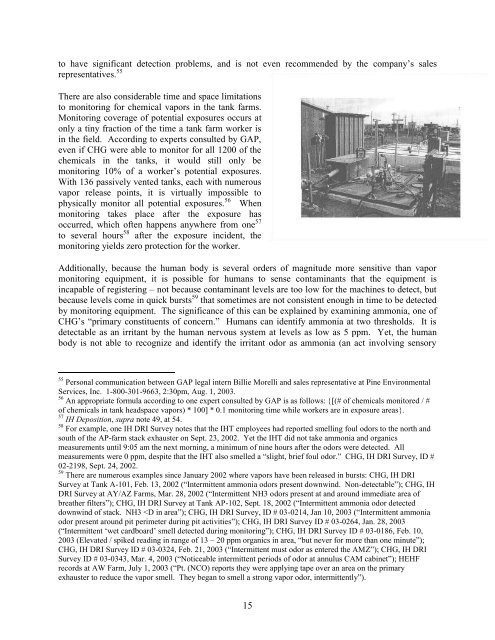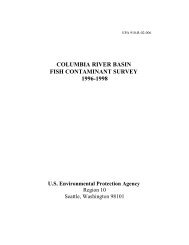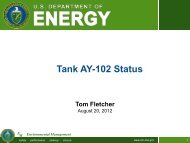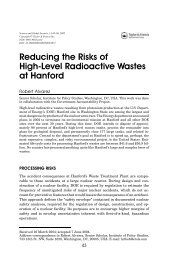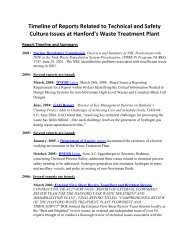Knowing Endangerment - Hanford Challenge
Knowing Endangerment - Hanford Challenge
Knowing Endangerment - Hanford Challenge
You also want an ePaper? Increase the reach of your titles
YUMPU automatically turns print PDFs into web optimized ePapers that Google loves.
to have significant detection problems, and is not even recommended by the company‟s sales<br />
representatives. 55<br />
There are also considerable time and space limitations<br />
to monitoring for chemical vapors in the tank farms.<br />
Monitoring coverage of potential exposures occurs at<br />
only a tiny fraction of the time a tank farm worker is<br />
in the field. According to experts consulted by GAP,<br />
even if CHG were able to monitor for all 1200 of the<br />
chemicals in the tanks, it would still only be<br />
monitoring 10% of a worker‟s potential exposures.<br />
With 136 passively vented tanks, each with numerous<br />
vapor release points, it is virtually impossible to<br />
physically monitor all potential exposures. 56 When<br />
monitoring takes place after the exposure has<br />
occurred, which often happens anywhere from one 57<br />
to several hours 58 after the exposure incident, the<br />
monitoring yields zero protection for the worker.<br />
Additionally, because the human body is several orders of magnitude more sensitive than vapor<br />
monitoring equipment, it is possible for humans to sense contaminants that the equipment is<br />
incapable of registering – not because contaminant levels are too low for the machines to detect, but<br />
because levels come in quick bursts 59 that sometimes are not consistent enough in time to be detected<br />
by monitoring equipment. The significance of this can be explained by examining ammonia, one of<br />
CHG‟s “primary constituents of concern.” Humans can identify ammonia at two thresholds. It is<br />
detectable as an irritant by the human nervous system at levels as low as 5 ppm. Yet, the human<br />
body is not able to recognize and identify the irritant odor as ammonia (an act involving sensory<br />
55 Personal communication between GAP legal intern Billie Morelli and sales representative at Pine Environmental<br />
Services, Inc. 1-800-301-9663, 2:30pm, Aug. 1, 2003.<br />
56 An appropriate formula according to one expert consulted by GAP is as follows: {[(# of chemicals monitored / #<br />
of chemicals in tank headspace vapors) * 100] * 0.1 monitoring time while workers are in exposure areas}.<br />
57 IH Deposition, supra note 49, at 54.<br />
58 For example, one IH DRI Survey notes that the IHT employees had reported smelling foul odors to the north and<br />
south of the AP-farm stack exhauster on Sept. 23, 2002. Yet the IHT did not take ammonia and organics<br />
measurements until 9:05 am the next morning, a minimum of nine hours after the odors were detected. All<br />
measurements were 0 ppm, despite that the IHT also smelled a “slight, brief foul odor.” CHG, IH DRI Survey, ID #<br />
02-2198, Sept. 24, 2002.<br />
59 There are numerous examples since January 2002 where vapors have been released in bursts: CHG, IH DRI<br />
Survey at Tank A-101, Feb. 13, 2002 (“Intermittent ammonia odors present downwind. Non-detectable”); CHG, IH<br />
DRI Survey at AY/AZ Farms, Mar. 28, 2002 (“Intermittent NH3 odors present at and around immediate area of<br />
breather filters”); CHG, IH DRI Survey at Tank AP-102, Sept. 18, 2002 (“Intermittent ammonia odor detected<br />
downwind of stack. NH3


